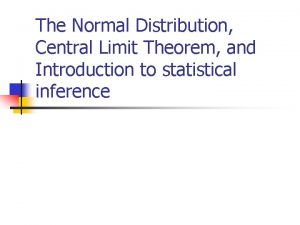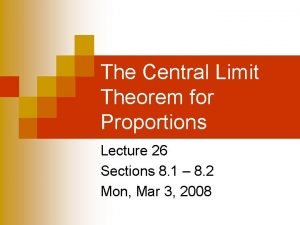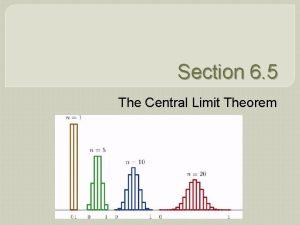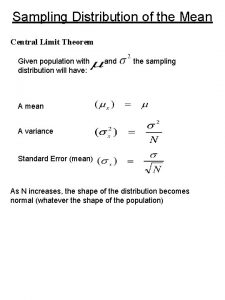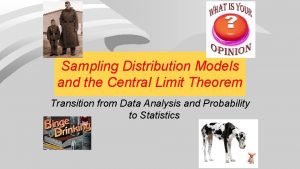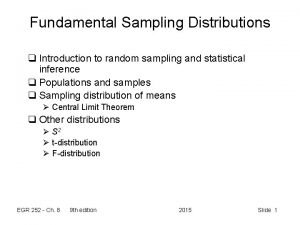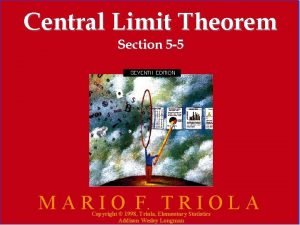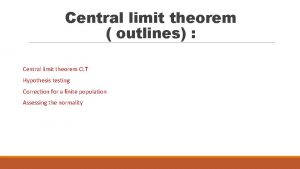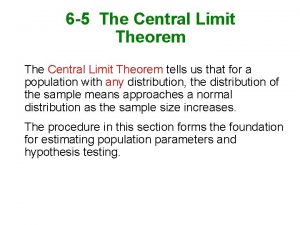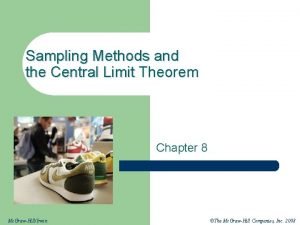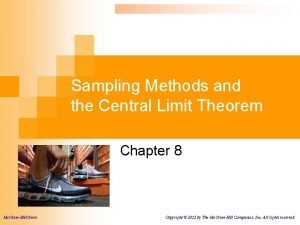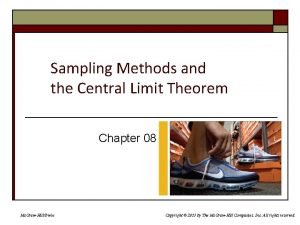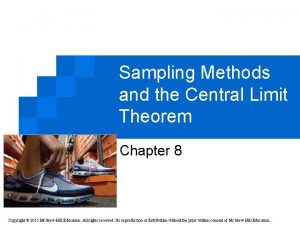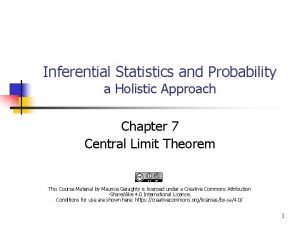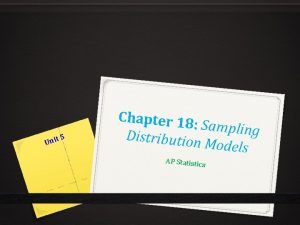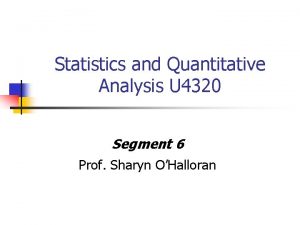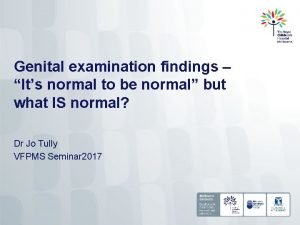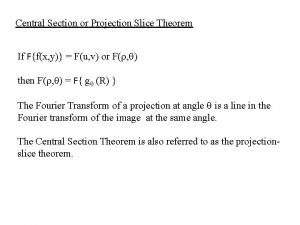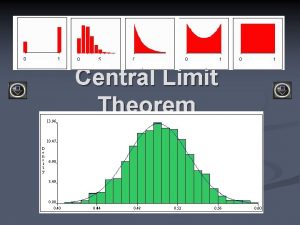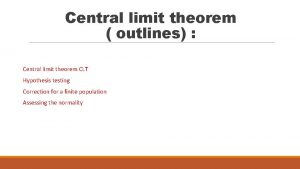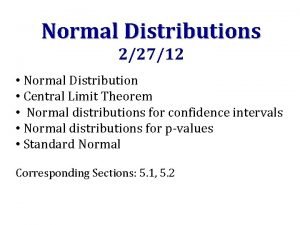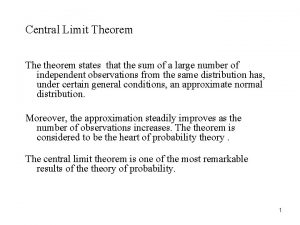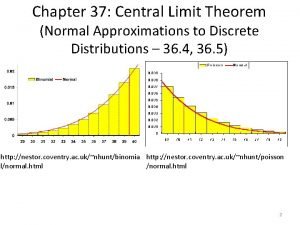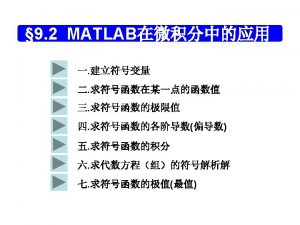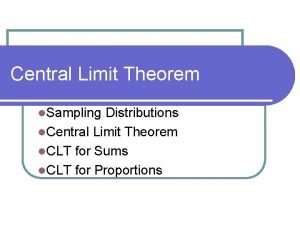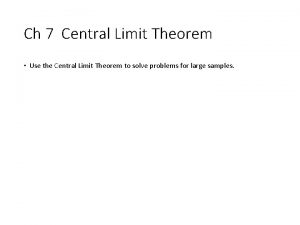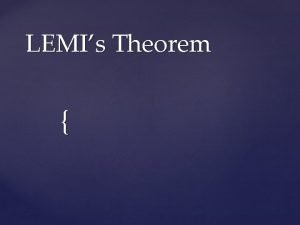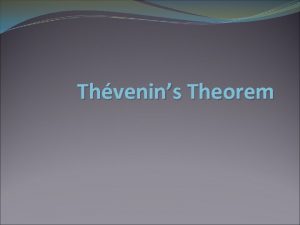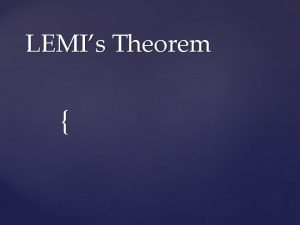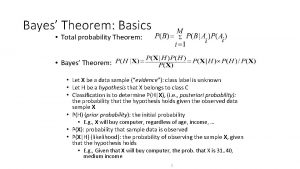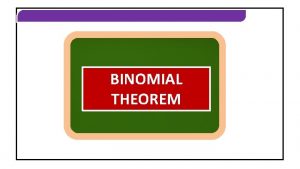THE CENTRAL LIMIT THEOREM The World is Normal

























- Slides: 25

THE CENTRAL LIMIT THEOREM The World is Normal Theorem

Sampling Distribution of xnormally distributed population Sampling distribution of x: N( , / 10) n=10 / 10 Population distribution: N( , )

Normal Populations Important Fact: If the population is normally distributed, then the sampling distribution of x is normally distributed for any sample size n.

Non-normal Populations �What can we say about the shape of the sampling distribution of x when the population from which the sample is selected is not normal? Population: interarrival times between consecutive customers at an ATM f(x) 0 time

The Central Limit Theorem (for the sample mean x) If a random sample of n observations is selected from a population (any population), then when n is sufficiently large, the sampling distribution of x will be approximately normal. (The larger the sample size, the better will be the normal approximation to the sampling distribution of x. )

The Importance of the Central Limit Theorem When we select simple random samples of size n, the sample means we find will vary from sample to sample. We can model the distribution of these sample means with a probability model that is

How Large Should n Be? For the purpose of applying the central limit theorem, we will consider a sample size to be large when n > 30.

Summary Population: mean ; stand dev. ; shape of population dist. is unknown; value of is unknown; select random sample of size n; Sampling distribution of x: mean ; stand. dev. / n; always true! By the Central Limit Theorem: the shape of the sampling distribution is approx normal, that is x ~ N( , / n)

The Central Limit Theorem (for the sample proportion p) If a random sample of n observations is selected from a population (any population), and x “successes” are observed, then when n is sufficiently large, the sampling distribution of the sample proportion p will be approximately a normal distribution.

The Importance of the Central Limit Theorem When we select simple random samples of size n, the sample proportions p that we obtain will vary from sample to sample. We can model the distribution of these sample proportions with a probability model that is

How Large Should n Be? For the purpose of applying the central limit theorem, we will consider a sample size to be large when np > 10 and nq > 10

Population Parameters and Sample Statistics Population parameter Value p proportion of population with a certain characteristic Unknown µ mean value of a population variable Unknown Sample statistic used to estimate The value of a population parameter is a fixed number, it is NOT random; its value is not known. The value of a sample statistic is calculated from sample data The value of a sample statistic will vary from sample to sample (sampling distributions)

Example

Graphically Sampling distribution of x: N( , / n) = N(15, 4/8) n=64 x = 4/ 64 = 4/8 Population distribution: =4 = 15, = 4 = 15

Example (cont. )

Example 2 The probability distribution of 6 -month incomes of account executives has mean $20, 000 and standard deviation $5, 000. a) A single executive’s income is $20, 000. Can it be said that this executive’s income exceeds 50% of all account executive incomes? ANSWER No. P(X<$20, 000)=? No information given about distribution of X

Example 2(cont. ) b) n=64 account executives are randomly selected. What is the probability that the sample mean exceeds $20, 500?

Example 3 A sample of size n=16 is drawn from a normally distributed population with mean E(x)=20 and SD(x)=8.

Example 3 (cont. ) c. Do we need the Central Limit Theorem to solve part a or part b? NO. We are given that the population is normal, so the sampling distribution of the mean will also be normal for any sample size n. The CLT is not needed.

Example 4 Battery life X~N(20, 10). Guarantee: avg. battery life in a case of 24 exceeds 16 hrs. Find the probability that a randomly selected case meets the guarantee.

Example 5 Cans of salmon are supposed to have a net weight of 6 oz. The canner says that the net weight is a random variable with mean =6. 05 oz. and stand. dev. =. 18 oz. Suppose you take a random sample of 36 cans and calculate the sample mean weight to be 5. 97 oz. Find the probability that the mean weight of the sample is less than or equal to 5. 97 oz.

Population X: amount of salmon in a can E(x)=6. 05 oz, SD(x) =. 18 oz § X sampling dist: E(x)=6. 05 SD(x)=. 18/6=. 03 § By the CLT, X sampling dist is approx. normal § P(X 5. 97) = P(z [5. 97 -6. 05]/. 03) =P(z -. 08/. 03)=P(z -2. 67)=. 0038 § How could you use this answer?

Suppose you work for a “consumer watchdog” group If you sampled the weights of 36 cans and obtained a sample mean x 5. 97 oz. , what would you think? Since P( x 5. 97) =. 0038, either you observed a “rare” event (recall: 5. 97 oz is 2. 67 stand. dev. below the mean) and the mean fill E(x) is in fact 6. 05 oz. (the value claimed by the canner) the true mean fill is less than 6. 05 oz. , (the canner is lying ).

Example 6 X: weekly income. E(x)=600, SD(x) = 100 n=25; X sampling dist: E(x)=600 SD(x)=100/5=20 P(X 550)=P(z [550 -600]/20) =P(z -50/20)=P(z -2. 50) =. 0062 Suspicious of claim that average is $600; evidence is that average income is less.

Example 7 § 12% of students at NCSU are left-handed. What is the probability that in a sample of 50 students, the sample proportion that are lefthanded is less than 11%?
 Define null hypothesis
Define null hypothesis Central limit theorem with proportions
Central limit theorem with proportions Rules of central limit theorem
Rules of central limit theorem Central limit theorem standard error
Central limit theorem standard error Central limit theorem
Central limit theorem Onlinestatbook central limit theorem
Onlinestatbook central limit theorem Central limit theorem formula
Central limit theorem formula Rules of central limit theorem
Rules of central limit theorem Clt formula
Clt formula Central limit theorem rules
Central limit theorem rules Sampling methods and the central limit theorem
Sampling methods and the central limit theorem Sampling methods and the central limit theorem
Sampling methods and the central limit theorem Sampling methods and the central limit theorem
Sampling methods and the central limit theorem Limit sample
Limit sample Central limit theorem probability
Central limit theorem probability Central limit theorem conditions
Central limit theorem conditions Central limit theorem conditions
Central limit theorem conditions Central limit theorem formula
Central limit theorem formula Relation between green's theorem and stokes' theorem
Relation between green's theorem and stokes' theorem Upper specification limit and lower specification limit
Upper specification limit and lower specification limit Upper specification limit and lower specification limit
Upper specification limit and lower specification limit Gambarlah grafik fungsi f(x) limit
Gambarlah grafik fungsi f(x) limit Limit comparision test
Limit comparision test Hymen
Hymen Sarah bohndiek
Sarah bohndiek Central section theorem
Central section theorem
